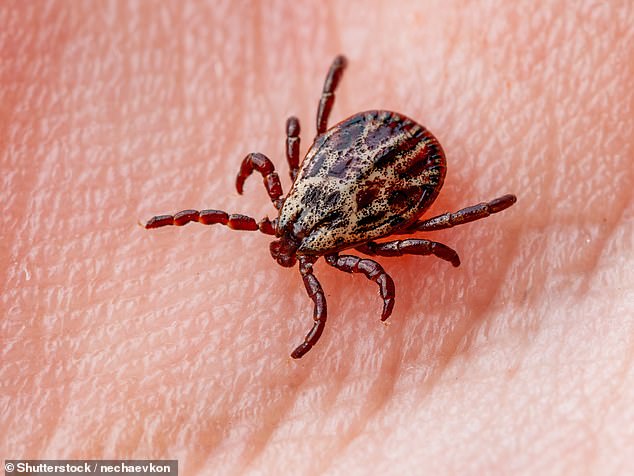Scotland could face a plague of TICKS thanks to climate change: Numbers of the pests will double if temperatures rise by just 4°C, study warns
- Computer models predict how tick numbers in Scotland will change by 2080
- An increase in ticks could also cause an increase in Lyme disease cases
Scotland could be facing a tick plague as a result of climate change.
This is according to scientists from the University of Stirling, who have used computer models to predict how the number of plagues will change by 2080.
Under the most optimistic climate change scenario, where global temperatures rise by 1°C, they predict tick prevalence in Scotland will increase by a quarter.
However, if temperatures rise by just 4°C, numbers will almost double, the team said.
Of concern is that an increase in ticks could also lead to an increase in cases of Lyme disease, a bacterial infection that can be transmitted to humans by infected ticks.
Scotland could face tick plague – climate change is to blame (stock image)

The team developed a model that predicts tick density by 2080 under different climate change scenarios – including no change in temperature (top left) and a global temperature increase of 1°C (top right), 2°C (bottom left) or 4°C (bottom right)
Adult ticks are only 1 cm long and about the size of an apple seed.
But despite their small size, ticks can transmit nasty viral and bacterial infections to both animals and humans, including Lyme disease.
‘Ticks that can cause Lyme disease are found throughout the UK, but places at high risk are grassland and woodland in the south and north of England and the Scottish Highlands,’ the NHS explains.
In their new study, the researchers wanted to find out how tick numbers in Scotland might change as temperatures continue to rise.
The team developed a model that predicts tick density by 2080 under different climate change scenarios – including no change in temperature and a global temperature increase of 1°C, 2°C or 4°C.
The results show that if global temperatures rise by 1°C, tick prevalence will increase by 26 percent.
But if global temperatures rise by 4°C, tick prevalence will increase by 99 percent.
As for the locations that could be affected, the researchers warn that in the most extreme scenario, only the highest mountain peaks in Scotland would remain tick-free.

Worryingly, an increase in ticks could also lead to an increase in cases of Lyme disease – a bacterial infection that can be transmitted to humans by infected ticks.
“The strength of these predicted increases in tick density varied depending on habitat,” said Professor Rachel Norman, who led the study.
‘Although forest areas were predicted to experience the largest absolute increases, the largest proportional increases were predicted for mountain slopes, the so-called mountain areas.
‘Many of these areas that were predicted to be tick-free under recent climatic conditions would be warm enough by 2080 to support a sustained tick population.’
Although this study focused on ticks in Scotland, the researchers say their model could be applied to other countries or even other vector species.
‘We developed the approach to predict tick density in Scotland, but it can easily be used for other areas and other vector species. In addition, pathogens can be added to the model, making it possible to predict disease risk,’ adds Professor Norman.
‘This methodology can indeed be used more broadly to understand the dynamic response of populations over time to a variety of environmental changes. Moreover, it provides researchers with a useful new method in the modeling toolbox to choose from.’
